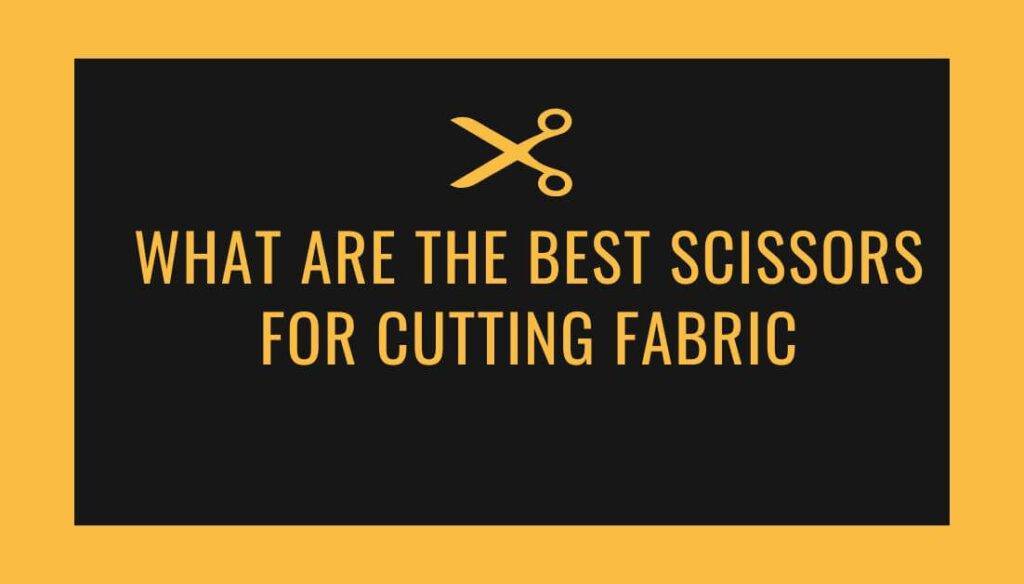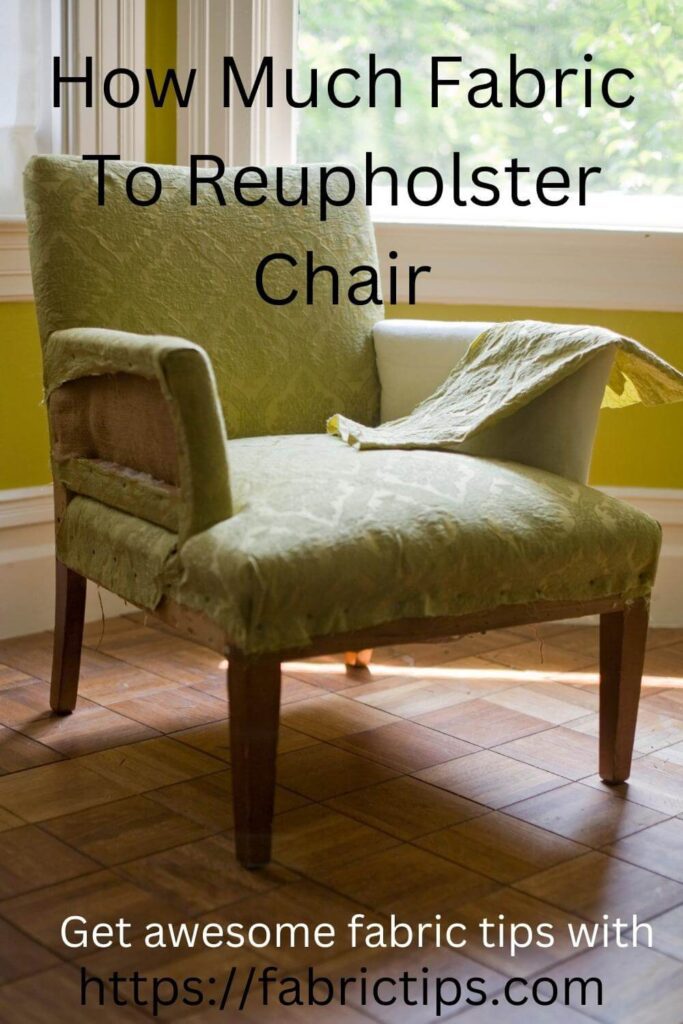Last Updated on December 13, 2025 by Wahid
Quilters have so many choices when it comes to scissors. The question is, which ones are really necessary?
Different things, such as preference & skill level, will affect that. Whenever you open any quilter’s toolbox, you’ll probably find a variety of scissors in different sizes and shapes. A good pair of scissors is essential if you love quilting, and they will be worth every penny once you purchase them. If you’re wondering which one to buy for your collection, here are our picks for the best sewing scissors for quilters.
Like me, are you left-handed? Regardless, I have included a link to left-handed scissor options, and the post also contains a left-handed scissor section. All other links are assumed to work with either right-handed scissors or scissors that work both left-handed and right-handed.
FAQs About Choosing the Best Scissors for Cutting Fabric
These FAQs, sourced from platforms like Quora and Reddit, provide valuable insights into what are the best scissors for cutting fabric, catering to a wide range of needs from beginner to expert levels. They cover essential aspects of selection, maintenance, and usage, guiding you toward making informed decisions in your sewing endeavors.
Q-1: What Makes a Pair of Scissors Ideal for Fabric Cutting?
Answer: Ideal fabric scissors have sharp, smooth blades, and comfortable grips, and are made of durable materials like stainless steel. The right scissors should match the fabric type and cutting needs.
Q-2: How to Choose Between Rotary Cutters and Fabric Scissors?
Answer: Rotary cutters are best for straight lines and large volumes of fabric, while fabric scissors offer more precision for intricate cuts. Your choice depends on the project’s nature and your comfort with each tool.
Q-3: What are your recommendations for left-handed sewers?
Answer: Look for scissors specifically designed for left-handed users, ensuring the blades are reversed for ease of use. Brands like Fiskars and Gingher offer good options.
[amazon box=”B0B7J7X19T” description=”none”]
Q-4: Which fabric scissors are the best for beginners on a budget?
Answer: Fiskars Razor-edge Softgrip Scissors are a great choice for beginners due to their affordability, ergonomic design, and excellent cutting ability.
[amazon box=”B00IPIWQLA” description=”none”]
Q-5: How Often Should Fabric Scissors Be Sharpened?
Answer: Depending on usage, fabric scissors should be sharpened every few months or when you notice a decline in cutting performance.
Q-6: Can the Same Scissors Be Used for Different Types of Fabric?
Answer: While it’s possible, using different scissors for various fabrics (like delicate fabrics vs. heavy materials) can extend the life and efficiency of the scissors.
Q-7: Are Expensive Scissors Worth the Investment for Occasional Sewists?
Answer: For occasional sewists, mid-range scissors can be sufficient. However, investing in a high-quality pair can enhance the sewing experience and offer long-term durability.
Q-8: How to Care for Fabric Scissors to Prolong Their Life?
Answer: Keep them clean, dry, and well-oiled. Store them in a dry place and use them exclusively for fabric to prevent dulling the blades.
Q-9: What Is the Best Way to Store Fabric Scissors?
Answer: Store them in a case or a protective sheath in a dry place. Avoid leaving them open or in a position where the blades can get damaged.
Q-10: Is It Better to Repair or Replace Dull Fabric Scissors?
Answer: If the scissors are of high quality, repairing or sharpening is a good option. Replace them if they are inexpensive or if the damage is beyond repair.
Q-11: Can Fabric Scissors Cut Through Multiple Layers of Fabric?
Answer: Yes, but it requires scissors with longer blades and a strong build. Ensure the scissors are sharp enough to avoid jagged edges.
Q-12: How Should Fabric Scissors Be Used On Delicate Fabrics?
Answer: Use sharp, fine-pointed scissors, and avoid pulling the fabric while cutting. Cutting on a flat surface also helps in achieving precision.
Answered: What Are The Best Scissors For Cutting Fabric
I have compiled a list of my top 10 favorite fabric cutting scissors. I cannot sew without three pairs of scissors – and if you can afford them, there are more I recommend. I am confident that you will find the right pair of scissors for you on the list below.
01. LIVINGO Fabric Scissors – Best Overall
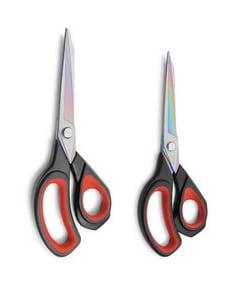
In case you’re looking for anything fancy, LIVINGO fabric scissors might be what you’re looking for. It comes with a titanium-coated rainbow blade, which makes cutting almost therapeutic. Besides looking much better than an average scissor, it ensures excellent precision as well.
Scissors are heavy items, so weight plays a major role. In general, heavier items are more difficult to use. Lightweight materials have been used on these handles to minimize their weight. Consequently, your scissor is easier to maneuver and control.
Titanium-coated forged steel blades make the scissor stand out. In addition to its aesthetics, ceramic blades are 3 times stronger compared to regular steel. Having gone through 44 separate sharpening processes, the blade is capable of cutting 16 layers of fabric.
Pros:
- Blades made of forged steel are 3 times sturdier than ordinary steel blades
- The blades have a rainbow-colored coating due to the titanium
- Handle is lightweight and easy to operate
- Comfortable handle with soft grip
Cons:
- For left-handed users, this can be uncomfortable
Get it Now from Amazon
2. Gingher Fabric Scissors – Best for Sewing
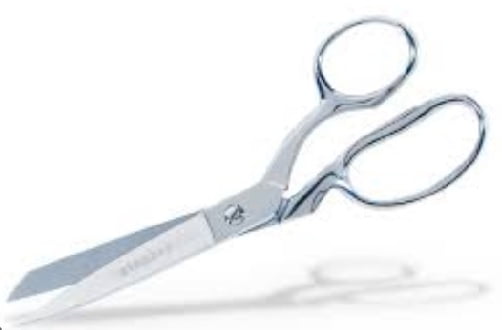
We’ve chosen the next pair of shears due to its fine tailoring, making it a top choice among sewing enthusiasts. In addition to their premium grade stainless steel construction, the Gingher Fabric Shears are hot forged, polished, ground, and tuned by skilled technicians to ensure longevity & performance. Holding these scissors flat on the surface allows them to easily cut the fabric with their bent handles. It is a reliable & traditional pair of fabric scissors. In addition to the blades, these fabric scissors come with a protective nylon sheath.
PROS
- Exceptionally sharp & reliable
- Cuts with precision and smoothness
- The handle is bent for easy maneuverability
- Reliable & traditional pair of fabric scissors
CONS
- There is a possibility of blades becoming loose
Get it Now from Amazon
3. iBayam Fabric Scissors – Best for Crafting
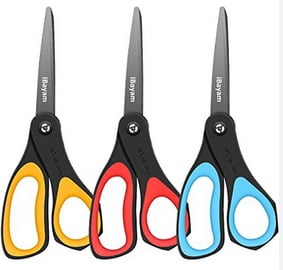
The multipurpose 8-inch cutter from iBayam is also a top pick for the best fabric scissors. By combining suitable design & build materials, the cutter is able to cut through cardboard, paper, tape, fabrics, and photos.
The versatility of these scissors makes them an excellent pair of general purpose scissors, ready to assist you with everyday tasks.
Additionally, stainless steel high-density blades are used. The enhanced strength of these scissors makes them a superior choice compared to ordinary steel scissors. Moreover, it is composed of steel that is 6 times more durable- making it durable for a longer period of time.
Furthermore, the blade of the iBayam fabric scissors has been thickened to 2mm, which makes it more useful for a variety of fabrics. Due to the enhanced blade thickness, this scissor will easily cut through cardboard and hard surfaces.
Pros:
- There are 3 in the set
- Suitable for a wide variety of materials
- Smooth cutting experience due to thickened blades
- Fingers are less stressed with a comfortable handle
Cons:
- There are some scissors with bad plastic mold finishes
Get it Now from Amazon
4. Fiskars Original Orange Handled Fabric/Cloth Scissors

Fiskars has earned a reputation for manufacturing high-quality scissors. Due to their classic style & sturdy construction, Fiskars scissors are durable and long-lasting.
In order to determine the best scissors to use when cutting fabric, different types of fabrics must be considered. It is important that the scissors you purchase can be used on soft materials such as cotton & hard denim as well.
A unique design on the blades makes them capable of cutting through all types of fabrics. Additionally, the precision-ground edge provides smooth cutting.
Aside from that, Fiskars fabric scissors can also be cut through a variety of other materials besides fabrics. With acrylic glue, cutting sticky fabrics or paper can be problematic because the glue jams the blades. Featuring an orange color, the blades are non-stick so your cuts will be smooth and free of gum.
Pros:
- Clean, tidy cuts with precision-ground blades
- Designing ergonomic handles to improve comfort
- Blades are non-stick to prevent jamming
- A curved handle improves the accuracy of cutting
Cons:
- For long periods of cutting, plastic handles may be uncomfortable
Get it Now from Amazon
5. JISTL Green Professional Dressmaking Pinking Shears – Zig Zag Cut Scissors
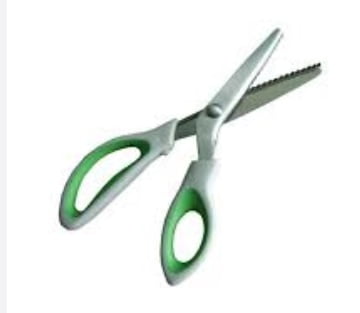
Regardless of the project you are working on, creativity plays a vital role in its success. Here are our picks for the best zigzag scissors from JISTL, allowing you to create more intricate patterns. As a form of design, you can now make zigzag edge patterns without fraying the edges.
These scissors are a must-have because of their comfortable handles. Handles have a soft material on the inner edges that reduces finger stress. Thus, you are able to carry out larger projects & cut them for longer periods of time. Additionally, due to their grippy texture, these handles are easier to maneuver.
In fact, zigzag fabric scissors won’t be helpful for removing inside shapes from a piece, even so, they are worthwhile to invest in. Many fabric designers are unable to incorporate zigzag cutting patterns into their pieces. This is a long-term investment because it is built from high-grade steel.
Pros:
- Maintains a consistent pattern of zigzags
- Durable construction from steel grade A
- The design of handles provides greater comfort
- An easy to maneuver handle texture
Cons:
- Large sheets are more difficult to cut with the short length
Get it Now from Amazon
6. SINGER Fabric Scissors with Comfort Grip for Both Right & Left Handed Person
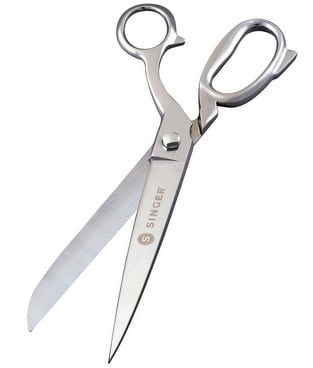
People have always preferred Singer sewing shears. With its 8.5-inch design, one fabric scissor offers comfort and precision in equal measure. Due to the rubber grips, cutting can be done comfortably for long periods of time.
A high-quality stainless steel blade ensures long-term use. Rust resistance has also been improved by the singer’s use of multiple layers of protection. Keeping the scissors in good shape at high speeds prevents fraying.
Aside from that, the blade is polished to perfection, enhancing the versatility of the scissor. It allows you to cut easily through a variety of fabrics, approximately 8 sheets of paper, as well as cardboard. Therefore, regardless of whether you are cutting fabrics, you should keep these scissors beside you for multipurpose uses.
Pros:
- Left-handed & right-handed users can use it
- It is scratch- & nick-proof, enhancing its durability
- Multilayer fabrics are cut simultaneously
- Stainless steel blades provide smooth cutting
Cons:
- Resharpening the blade is only possible a few times
Get it Now from Amazon
7. BIHRTC Professional 9-inch Sharp Tailor Scissors & Small Decorative Embroidery Scissors
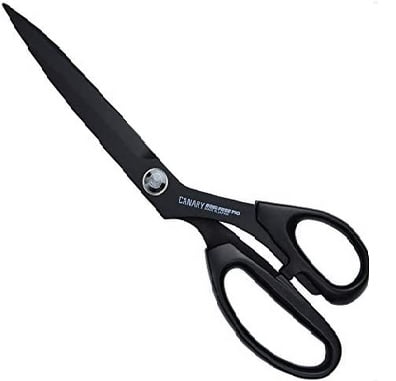
You may be more interested in purchasing scissor kits, then this next offering from BIHRTC might make you go “wow.” In addition to basic fabric scissors, BIHRTC includes 2 embroidery scissors, which are capable of being used in several ways.
However, high-carbon steel blades are capable of cutting through all kinds of materials with no mercy. Whether you’ve got multiple layers of cotton or hard denim, you’ll be able to cut them as smoothly as butter with this pair of scissors. By pairing it with its ground-to-precision edge, the cutting experience will be seamless.
Furthermore, the handles of the scissor are comfortably padded with rubber. You shouldn’t experience any finger pain from the ergonomic design and grip. The scissors at BIHRTC are usually oiled before shipping, which means you will exert less pressure right away.
Pros:
- Comfortable rubber grips ensure long-term use
- Enhanced durability through high carbon steel
- Precision-ground blades cut through right to the end
- Cutting is smoother with pre-lubricated blades
Cons:
- No cons were found for this product
Get it Now from Amazon
8. CYNAMED German Premium Heavy-Duty Fabric Cutting Scissors
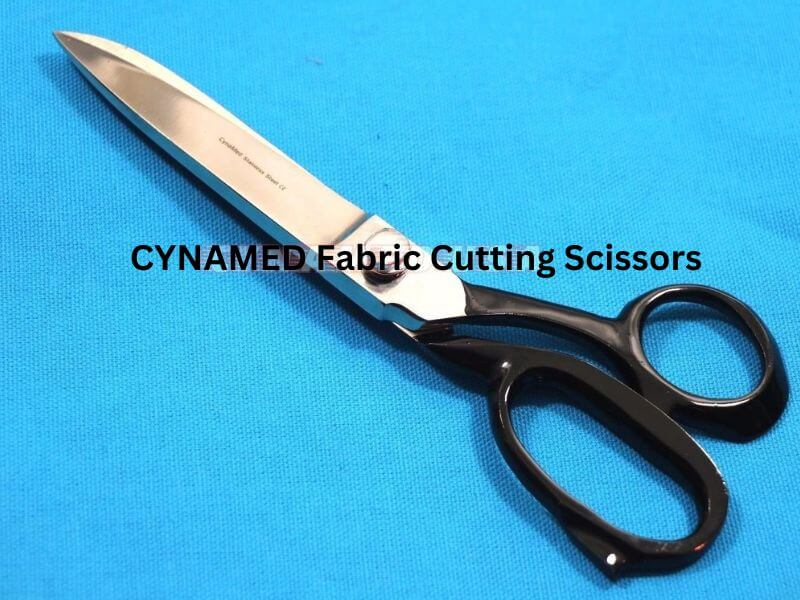
A typical 8-inch scissor is usually preferred, but larger sizes provide faster performance. CYNAMED’s next generation of scissors is made entirely in Germany from start to finish. A heavyweight such as this 12-inch model is ideal for reducing the time needed to cut long fabrics.
With a blade made from only the best German stainless steel, the edge remains sharp for a long time. With the scissor being heavy-duty, wear and tear will be no problem.
With the exception of oiling it every now & then, it doesn’t require much attention. Due to the fact that the german steel will require less sharpening, you can focus on making your new outfit.
Furthermore, they have a larger handle than standard fabric scissors, making it easier for you to manipulate them. If you can grip the handle comfortably over your entire hand, you will be able to make more accurate cuts.
Pros:
- A steel of German quality ensures durability
- The longer length makes large pieces easier to cut
- It is quite a long before the blade loses its edge
- Large handles make cutting more comfortable
Cons:
- Useful for larger cuts, but difficult for smaller ones
Get it Now from Amazon
9. P.LOTOR Scalloped Pinking Shears – ZigZag Fabric Craft Scissors
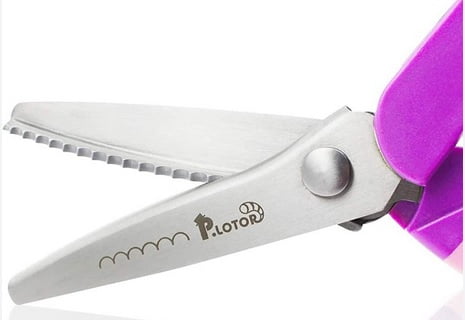
For the last item on our list, here are these decorative scallop fabric shears from P.lotor. Much like the zigzag cutters we mentioned previously, scallop cutters can be used to make rounded patterns. Apart from tailoring, they’re great companions for DIY projects as well!
With regard to the specifications, the stainless steel blades on these pinking shears provide smooth cutting.
In case you’ve ever used patterned scissors, you’re already familiar with the difficulties of working with soft materials. Unlike most scissors, this one provides a clean cut. Whether you use soft or hard fabrics, once you press down the blades, the edges will be smooth and rounded.
Aside from that, the handle design is suitable for both right- & left-handed individuals. By doing so, lefties no longer have to struggle to adjust to scissors that are right-handed. Therefore, regardless of whether the user is left- or right-handed, everyone can use these scissors.
Pros:
- Precision is enhanced by ball-bearing joints
- For long-lasting performance, stainless steel blades are used
- A left-handed & right-handed handle design is available
- Cleanly cuts patterns through a wide range of materials
Cons:
- Their weight makes them difficult to maneuver
Get it Now from Amazon
10. Havel’s 30212 Serrated Fabric Scissors
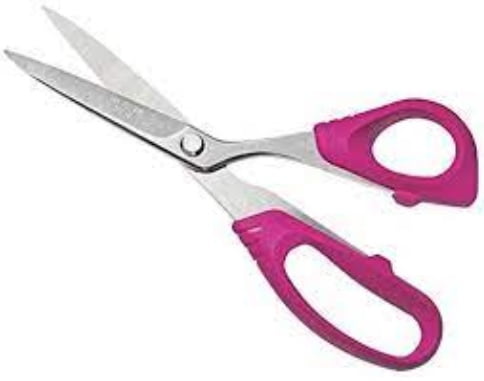
Sewing and embroidery tools have been made by Havel Sewing since 1981. Cincinnati, Ohio-based company started off selling medical devices and eventually added sewing tools. Scissors from this company are valued by sewing professionals as they provide both functionality and comfort.
A slippery fabric, such as chiffon, silk, or satin, makes scissors difficult to handle. Fabric slides right off the blades due to their smooth nature. To ensure precise cutting, make use of a serrated blade. Serrated scissors work like a steak knife: it increases cutting efficiency by grabbing onto slippery or sensitive fabrics. The edges aren’t perfectly straight, but they don’t zig-zag like pinking shears.
Stainless steel blades measure 8 inches and have a smooth, serrated edge. Their grip and precision will make grabbing and cutting slippery fabric a breeze. In addition to the comfortable handle, these scissors feature a grip that offers added control. Additionally, the blades are protected by a cover.
Pros
- Blades are protected by a cover
- An added grip enhances control
- Similar to a steak knife, serrated scissors have serrated blades
- Grabbing slippery or sensitive fabrics increases cutting efficiency
Cons
- Chiffon, silk, and satin are difficult to handle with scissors
Get it Now from Amazon
Left-Handed Scissors For Quilters
- Left-handed pinking shears
- Tula Pink Left Hand Shears 8 inch
- Kai Dressmaking Shears – Left-Handed Version
- In most cases, the Embroidery Scissors and Trimming Snips we mentioned are also suitable for left-handed people.
The right pair of sewing scissors is undoubtedly one of the most critical items in a quilter’s sewing kit. Therefore, you should spend some time selecting them carefully.
Our thinking as quilters is that we have to have ‘everything’. However, only some high-quality, good-looking scissors are needed. It is important to pick scissors that are right for you.
Care & Maintenance Of Fabric Scissors: Ensuring Longevity & Precision
Proper care and maintenance are crucial for keeping your fabric scissors in the best condition, especially when considering the question, “What Are The Best Scissors For Cutting Fabric?” Here are essential tips on cleaning, sharpening, storing, and using your fabric scissors to maintain their sharpness and effectiveness.
1. Cleaning Your Scissors:
- Regular Cleaning: After each use, wipe the blades with a soft, dry cloth to remove any fabric lint or moisture.
- Deep Cleaning: Occasionally, use isopropyl alcohol on a cloth to clean the blades thoroughly, especially if you’ve used adhesive products.
2. Sharpening Fabric Scissors:
- Frequency of Sharpening: Sharpen your scissors as soon as you notice any snagging or difficulty in cutting. For frequent users, sharpening every few months is recommended.
- Professional Sharpening: Consider getting your scissors sharpened by a professional, especially for high-quality scissors, to ensure the correct angle and edge.
3. Storing Fabric Scissors:
- Proper Storage: Store your scissors in a dry place, away from moisture and dust. A protective case or sheath can prevent damage to the blades.
- Avoiding Damage: Never store them in a position where the blades are open or could be easily damaged.
4. Exclusive Use for Fabric:
- Maintaining Sharpness: One of the key practices in maintaining the sharpness of your fabric scissors is to use them exclusively for cutting fabric. Cutting paper or other materials can dull the blades quickly.
- Labeling Scissors: Label your fabric scissors to prevent their use on non-fabric materials, especially if you have multiple scissors in your workspace.
However, by following these care and maintenance tips, you can significantly extend the life and maintain the performance of your fabric scissors. Understanding the importance of these practices is essential in answering “What Are The Best Scissors For Cutting Fabric?” as it’s not just about the initial quality of the scissors but also how well they are maintained over time.
A Buyer’s Guide To Pick The Best Fabric Scissors
It might seem quite simple to select a set of fabric scissors, but choosing the best one is not straightforward. Consider these features prior to making your decision.
Ergonomic Design
In general, fabric needs more pressure when cut than paper. Thus, you should choose scissors that fit your fingers comfortably enough so that you can exert enough force.
Fabric scissors may have a flat bottom on one side, while the handle is raised on the other side. In this way, you can lay your scissor flat on the fabric as you cut.
Material Construction
In the long run, the quality of the scissors will determine their durability. Fabric scissors are typically made from stainless steel, making them the best option.
Due to stainless steel’s durability and corrosion resistance, I say this. Despite the fact that scissors do not come into contact with moisture, you should still be aware of humidity.
Other materials may appear practical and effective at first, but they quickly wear out.
Blade Length
In contrast to paper cutters, fabric cutters require longer blades for smooth cutting. In the simplest case, 21 centimeters would be required. It will be difficult to evenly cut through anything below that.
A pair of scissors can reach 26 centimeters in length, yet they are mostly used for speed. It is only suitable when precision isn’t an absolute necessity.
For fast cutting that doesn’t compromise accuracy, choose scissors between 21 and 24 cm long.
Long-term maintenance
In order to extend the life of your fabric scissors, the following tips may help.
To begin with, people commonly oil their hinges. The method can be useful when using regular scissors, however, fabrics are more likely to absorb the oil. Stainless steel scissors are an excellent alternative, as they’re rust-resistant and don’t require oiling.
In addition, make sure the blade is thick and can be ground frequently. Thinner bladed scissors cannot be ground and must be replaced more frequently.
Handle
Choosing the right fabric cutting scissors requires consideration of their handle design, materials, & sizes. Handles that avoid causing calluses on wrists or fingers should be your top priority.
Make sure the handle feels comfortable to hold as well. The wrong handle can exhaust your hand quickly.
For scissors with 2 equal holes, the top hole needs to fit comfortably over your thumb, while the bottom hole fits over your ring finger or index. With unequal holes, you should place your thumb top & middle, ring, ring finger, and pinky finger inside the bottom hole.
In terms of material, rubber, plastic, & metal are available. Ensure your comfort by choosing a handle that fits your 3 fingers comfortably.
Weight
For scissors that you plan to use for an extended period of time, it is paramount that they are lightweight. When you use heavy scissors, your hand feels weighed down, slowing down and requiring more effort. Stronger, heavier scissors provide more stability & leverage. Using lightweight scissors, by contrast, allows greater control of the cutting process.
A Guide To Sharpening Fabric Shears
With time, even the best scissors can be dull. You can use these methods to sharpen your scissors if you experience this problem. Additionally, if they are knicked rather than dull (for example, by cutting floral wire & pipe cleaners), grinders must be used to sharpen them. Occasionally, such damages cannot be repaired.
- If you do not have access to sharpening stones or waterstones, use a scissors sharpener like the ScissorPro electric sharpener.
- Loosen the screw before applying sewing oil to the joints. You should cut away all excess oil from old fabric scraps afterward.
- A dull pair of scissors should be sharpened by a professional. Check with your local hardware store, hair salon, sewing machine retailer, quilt shop, or fabric store and see who sharpens their blades.
- For specific scissors brands, check the brand’s own sharpening tools
- To sharpen pinking shears, the process isn’t quite as straightforward. The supplier may have its own sharpening facility so that the shears can be sharpened there.
Types of Fabric Scissors: Finding the Best Match for Your Fabric Needs
When it comes to tailoring and sewing, having the right tools is essential for achieving the best results. This is particularly true for scissors, a fundamental tool in fabric cutting. Understanding the types of fabric scissors and their specific uses is key to answering the question, “What Are The Best Scissors For Cutting Fabric?” Here we explore various scissors types and their suitability for different fabrics.
1. Dressmaker’s Shears:
- Description: Dressmaker’s shears are characterized by their long blades and angled handle, which allows for efficient cutting of large fabric swaths.
- Usage: Ideal for cutting straight, long cuts on a range of fabrics, from lightweight silks to heavier upholstery.
- Why They’re Best: Their ergonomic design reduces hand fatigue, making them a favorite for prolonged sewing projects.
[amazon box=”B002PNSWFA” description=”none”]
2. Pinking Shears:
- Description: Recognizable by their sawtoothed blades, pinking shears create a zigzag pattern on the fabric edge.
- Usage: Best used to prevent fabric fraying, especially useful for fabrics that unravel easily like chiffon or satin.
- Advantages: Apart from functionality, they offer a decorative edge, adding an aesthetic appeal to fabric projects.
[amazon box=”B001IKEJQM” description=”none”]
3. Embroidery Scissors:
- Description: These are small, with fine tips for precision cutting. Their short, sharp blades are perfect for intricate work.
- Usage: Primarily used in embroidery for snipping threads and detailed fabric work.
- Best For: Precise cuts and detailed work, where larger scissors would be too cumbersome.
[amazon box=”B000UUCA62″ description=”none”]
4. Tailor’s Scissors:
- Description: Tailor’s scissors are similar to dressmaker’s shears but often have a shorter blade length.
- Usage: Versatile for a variety of fabrics; however, they excel in precision cuts and are ideal for pattern work.
[amazon box=”B07L6MJQ6S” description=”none”]
5. Rotary Cutters:
- Description: While not scissors, rotary cutters are worth mentioning for their circular blades that roll across the fabric.
- Usage: Excellent for cutting straight lines and curves, and particularly useful for quilting and projects requiring precision.
Each type of scissors plays a specific role in fabric crafting. When selecting the best scissors for cutting fabric, consider the material you are working with and the nature of your project. Whether it’s creating flawless edges with pinking shears or doing intricate embroidery work, the right pair of scissors can make all the difference in your crafting experience. With the right knowledge of fabric shears types and the best scissors for different fabrics, you can ensure that every cut is a step towards a beautifully finished project.
[amazon box=”B0C8BQ8R8P” description=”none”]
Expert Tips and Tricks: Professional Insights on Choosing the Best Scissors for Cutting Fabric
Gaining insights from professional tailors and seamstresses can significantly enhance your understanding of what are the best scissors for cutting fabric. These seasoned experts have honed their skills over years of experience and are a treasure trove of valuable tips and tricks. Here, we compile their advice and highlight common mistakes to avoid, ensuring your fabric cutting is both efficient and effective.
1. Selecting The Right Scissors:
- Match Scissors to Fabric: Professionals emphasize the importance of choosing scissors based on the fabric type. For instance, lightweight fabrics like silk require sharp, fine-tipped scissors for precision, while heavier fabrics like denim may need stronger, more robust shears.
- Quality Matters: Invest in high-quality scissors. They might be more expensive, but they stay sharp longer, provide cleaner cuts, and are more durable.
2. Maintenance Is Key:
- Regular Sharpening: Keep your scissors sharp. Dull blades can damage fabric and make cutting more difficult.
- Proper Storage: Store scissors properly, preferably in a dry place and away from dust and moisture.
3. Correct Usage:
- Use Scissors Exclusively for Fabric: One common mistake is using fabric scissors on paper or other materials, which quickly dulls the blades. Reserve your fabric scissors solely for cutting fabric.
- Handle with Care: Practice proper hand positioning and ergonomics to avoid hand fatigue and ensure precision in cutting.
4. Avoiding Common Mistakes:
- Not Testing On Scraps: Before cutting your main fabric, test the scissors on a scrap piece, especially if trying a new pair or style of scissors.
- Ignoring Blade Tension: Check the tension of the scissors. It should be tight enough for control but not so tight that it causes strain.
5. Advanced Techniques:
- Layered Cutting: Learn to cut multiple layers of fabric efficiently, which can save time in large projects but requires practice to maintain accuracy.
- Curve Cutting Mastery: Mastering curved cuts with fabric scissors is crucial, especially for garment making.
Incorporating these expert tips into your fabric cutting routine can significantly enhance the quality of your work. Remember, knowing what are the best scissors for cutting fabric is just the first step; understanding how to use and maintain them properly is equally important for achieving the best results in your sewing and tailoring projects.
Frequently Asked Questions
01. How to choose when scissors range in price greatly?
Answer: When possible, try to find coupon codes. Take into account your budget. Depending on your budget, you can get started with the lowest-priced scissors & work your way up. Take a look at Kai scissors: they come in a variety of prices, and most people choose them because of their versatility. Despite the fact that professional dressmakers use better scissors, because they perform so well, they don’t notice they require better scissors.
[amazon box=”B018ORGMZC” description=”none”]
02. Will lightweight scissors cut as well as heavy weight scissors?
Answer: Personal preference and comfort play a big role. Take into account the fabric’s weight. Depending on the fabric, you can use heavy or light scissors. To avoid struggles with cutting, the heavy fabrics should be handled by shears that are heavier.
03. What cutting options are available for my arthritic hands or when I get hand fatigue?
Answer:
- Using electric scissors & rotary cutters is easier than using regular scissors, however, they have some limitations. Knits can be difficult to cut with electric scissors, for example.
- Make sewing easier by wearing fingerless compression gloves
- Make use of spring-loaded scissors
- Also, a good pair of sewing shears will make a big difference
04. What are pinking shears?
Answer:
- A zigzag pattern is used on the blades, preventing fraying on the raw edges of the fabric.
- This method is useful for shrinking fabric around seam allowances and for preventing fraying (compared to serging edges & sewing with zigzag stitches).
- There are people who collect scissors similarly to others who collect trinkets and coins (or like me, driftwood and seaglass).
So, if you are planning to purchase fabric shears soon, hopefully, this roundup will assist you in choosing scissors that will meet your needs.
05. How to Maintain Fabric Cutting Scissors?
Answer: In order to maintain the quality of your fabric scissors, make sure you apply oil or lubricants regularly and protect them against scratches and drops.
06. Which Scissors are Ideal for Sewing?
Answer: Sewing scissors are a good choice when it comes to cutting paper. Besides that, stitching scissors & pinking fabric shears can also be used to snip off snippets and pieces of loose thread.
07. What Makes a Good Fabric Scissor?
Answer: Apart from offering an effortless cutting experience, fabric scissors must also be easy to use & maintain in order to be effective.
08. Are Dishwashers Safe with Scissors?
Answer: Theoretically, dishwashers should be able to handle washing fabric scissors. However, washing dishes with soap & water can cause the metal to rust faster. Hand washing would be best.
09. Should I Prefer Thick Blades or Thin?
Answer: As thicker blades can be resharpened, they are a better choice. The blade has to be thin from the beginning, otherwise, it can’t be sharpened more than once.
10. Can I use fabric scissors for cutting paper?
Answer: Certainly, fabric scissors can be used for cutting paper, in addition to other materials. However, you should avoid doing this since it will dull the sharp edge of your scissors. Due to this, the fabric will not be cut as accurately as before.
11. Are fabric scissors any different from regular ones?
Answer: Although they seem similar, fabric scissors are both better in quality & more expensive. Not only are regular scissors cheaper, they are also less durable than fabric scissors of higher quality.
12. How often should I sharpen my fabric scissors?
Answer: Using your fabric scissors frequently greatly influences how often you need to sharpen them. If you are constantly using them, you may need to sharpen them every few months or whenever the blades seem dull. When you use them moderately, one sharpening a year is usually sufficient.
13. What can I use instead of fabric scissors?
Answer: The thread snippers work well for when you are pressed for time. While cutting a long piece of fabric will be challenging, it will be possible.
14. Does paper dull fabric scissors?
Answer: In fact, paper is composed of abrasive materials, which wear down fabric scissors over time.
Conclusion: Elevating Your Fabric Cutting with the Right Scissors
Finally, understanding ‘What Are The Best Scissors For Cutting Fabric’ is crucial for anyone engaged in sewing and tailoring. The journey through the types of fabric scissors – from dressmaker’s shears to pinking and embroidery scissors – highlights the importance of choosing the right tool for your specific fabric needs. Remember, the quality of your scissors significantly influences the precision and ease of your cuts, impacting the overall quality of your sewing projects. The care and preservation of your scissors are as essential as their initial selection.
Whether you’re a beginner or a seasoned professional, the right pair of scissors can transform your sewing experience, bringing efficiency, precision, & enjoyment to every project. As you move forward in your sewing endeavors, keep these insights and tips in mind. The right pair of fabric scissors is not just a tool; it’s an extension of your creativity and skill, helping you bring your textile visions to life with accuracy and style.
